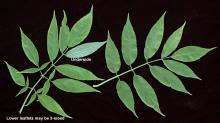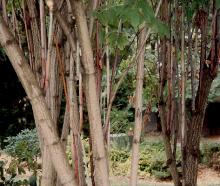Sambucus cerulea
Common name:
Blue Elderberry
Blueberry Elder
Pronunciation:
sam-BEW-kus ser-U-lee-ah
Family:
Adoxaceae, Caprifoliaceae
Genus:
Synonyms:
Sambucus nigra subsp. cerulea
Sambucus mexicana
Sambucus caerulea
Type:
Broadleaf
Native to (or naturalized in) Oregon:
Yes
- Broadleaf deciduous (nearly evergreen mild climates) tree or large shrub,15-30 ft (9-15 m) high, may form a thicket, has pithy stems. Leaves opposite, pinnately compound, 15-25 cm long, 5-7(9) leaflets, each 5-15 cm long and 1-5 cm wide, narrowly ovate or lanceolate, unequal at base, coarsely serrate, bright green (a variable species). Flowers yellowish-white, 5-lobed, 6 mm wide, in many branched, flat clusters. Fruit 6 mm, dark blue with whitish bloom, edible, but not very palatable fresh. When cooked makes a good jam, pie, and wine.
- Sun, prefers forest-edge location and moist soils.
- Hardy to USDA Zone 4 Native from British Columbia east to Montana and Utah, south to California and New Mexico. Shrubs in the genus Sambucus are the only ones found in the Pacific Northwest forests that have both opposite and pinnately compound leaves.
- Taxonomy: Richard Bolli published a monograph in 1994 titled, "Revision of the Genus Sambucus", in it he proposed the placement of 5 species of elderberry as subspecies of Sambucus nigra, including S. caerulea, Blue Elderberry, to S. nigra subsp. cerulea (note spelling) and S. canadensis, American Elderberry, to S. nigra subsp. canadensis. This change was accepted by the Integrated Taxonomic Information System (ITIS), but not the World Flora Online (WFO) as of March 2024.
- caerulea (now cerulea): dark blue
- Oregon State Univ. campus: in open area behind Dixon Lodge.
- Corvallis: River Front Park, along walkway south of Van Buren Ave.
Click image to enlarge


















